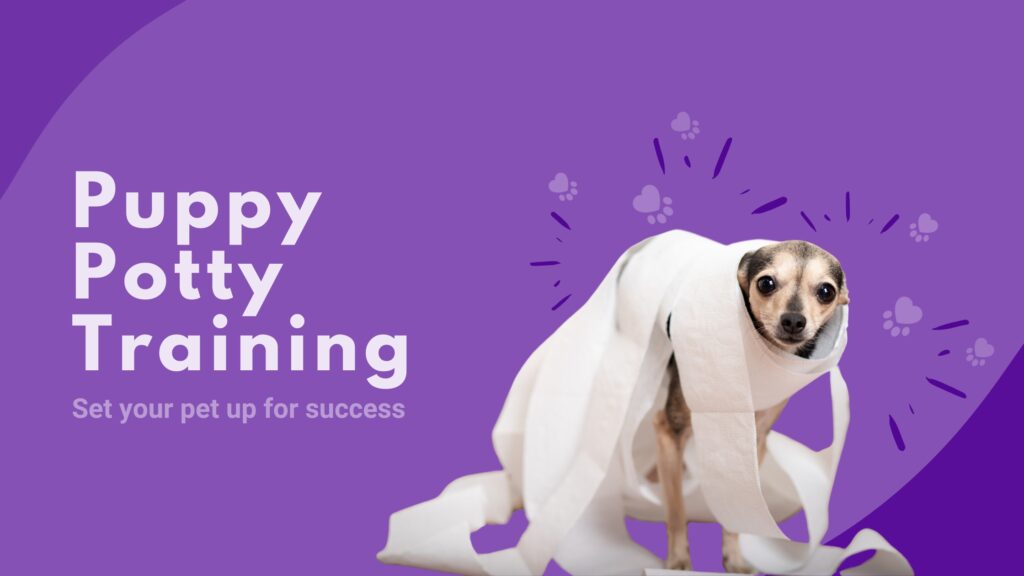
Pet Parent Potty-Training Tips
We all love puppies, but the messes that can come with them? Well..not so much! Potty training is different for every dog or puppy, but there are some basic guidelines everyone can start with. Read below for some “tricks of the trade” and how to use them.
Set & Maintain A Schedule
Knowing when your pet needs to go out is an essential part of potty training. Though the amount of time your pet can “hold it” slowly increases as your puppy grows, their bladders start small.
To calculate how long your puppy can hold their bladder, add your puppy’s age in months plus one for the maximum amount of hours they can wait. That’s age in months +1 hour. This means that a two-month old puppy can hypothetically hold its bladder for up to three hours, a four-month old puppy for four hours, and so on. While your puppy is still growing, remember to start by taking them out about every 2-3 hours, and within 20 minutes of when they eat or drink, to help create and reinforce a routine.
Hire A Dog Walker
If your job keeps you away from home for long hours, consider hiring a professional dog walker. While your busy schedule might not allow for all the potty breaks your new pet needs, they still require consistency in order to make progress with their training. Finding a good dog walker in your area can be an invaluable resource to help reinforce training and maintain a healthy routine. At YPCC we’ve helped many a pet, and their pet parents, navigate the ins and outs of maintaining their new puppy’s daily routine.
Get Excited To Go Outside
It’s never too early to start taking your pet outside to do their business. Even eight week old puppies can benefit from a consistent routine of being taken outside to go potty. Letting your new puppy get outdoor exposure through trips outside to go potty also helps your pet create a positive association with going outdoors from early on.
Make sure to treat your pet while they are still outside, to reinforce the behavior. Giving your pet treats once they get back inside can result in a pet who rushes for the door before they are “done”. Always get excited for a job well done. Using an excited, high-pitched, tone of voice to praise your pet after they “do their business” where they’re supposed-to to emphasize a job well done.
Have The Correct Training Tools
Having the correct potty training supplies, and using them properly, is essential to your pet’s success. Check out some of our pawsome recommendations, below.
- Potty Bells: This is one of our number-one recommendations to new pet parents. This straightforward design is something you hang on or next to your door to help your pet communicate when they need to go out. Start by ringing the bells every time you go outside with your dog. After a week, continue by using your dog’s paw to ring the bells, and then rewarding them with a treat once you’re outside. Most puppies’ pickup on this quickly, and start ringing the bells to go out in less than a month!
- Avoid Potty Pads: While using potty pads can be convenient, and a good back-up plan, they can also delay your pets potty training by creating a positive place to go in the house. If you choose to use potty pads, try to find a spot close to the door so you can get them to transition outside for the next stage of training.
- Get An Enzymatic Cleaner: Pet-specific enzymatic cleaners help break down the enzymes found in your pet’s urine and feces, to help prevent re-marking. While potty training, most pets tend to select a “fail-safe” spot in the house if they can’t (or don’t want to) make it outside in time. Using a quality enzymatic pet cleaner helps deter your pet from going back to the same spot by breaking down the odor where they may have gone before.
Set Your Pet Up For Success
Removing the temptation of “boredom drinking” while in the crate helps your pet to fully empty their bladder beforehand, and prevent accidents in the crate. Take up your pet’s water bowl approximately 2 hours before they go to bed, and at least 30 minutes before putting them in the crate while you’re away.
The importance of a quality crate can never be overstated. Whether it’s for a puppy or a newly adopted adult dog, a crate is an essential resource for both you and your pet. Crating not only helps reinforce good behavior, but also provides a safe and positive place for your pet when they’re tired or overwhelmed. Get your puppy started early, and keep them on the potty-training bandwagon.
To further reinforce positive behavior, consider using a professional dog walker to keep your pet set up for success and on routine.
Use Engaging Toys
Even if your pet is physically worn-out from a full day of exercise with your dog walker, your pet still needs mental stimulation to stay healthy, well rounded, and mischief free.
If your pet doesn’t feel mentally stimulated enough they may resort to unwanted behaviors such as chewing, barking, or boredom drinking. Making sure your dog is mentally stimulated helps deter these behaviors and eliminate boredom habits like excessive water drinking, thus helping you with potty training. Many professional pet care providers, like YPCC, often offer enrichment pet care services to engage your pets brain and deter these kinds of boredom behaviors.
Pro Tip: Using a quality assortment of chew toys, hard and soft toys, and interactive toys helps eliminate boredom while promoting a positive energy outlet. Select a few safe and engaging toys as boredom busters for your pet, and rotate them out to keep your pet’s interest.
Here To Help Pet Parents Succeed
Whether it’s a midday walk to support your new puppy through potty training and keep them on routine or a pet enrichment session to keep your pup entertained, YPCC is here to support you every step of the way.
Contact us now to learn more about our services and discounts. Let’s make potty training a breeze—for you and your fur-family!







